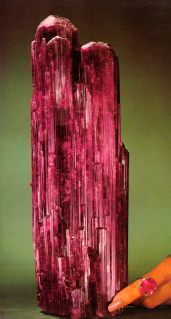 |
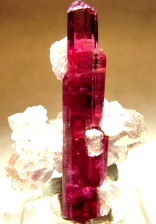 |
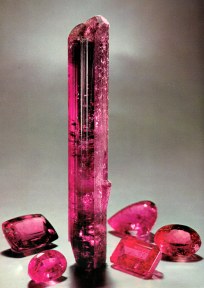 |
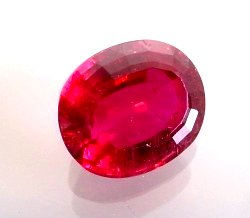 |
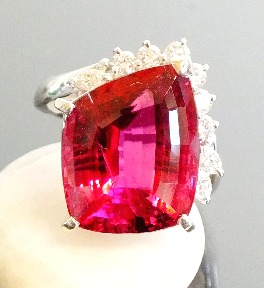 |
| 結晶 高さ 35cm | 高さ 4.5cm | 結晶 12cm と ルース | 12.7ct 15.7x13.0x8.6mm | 14 .99ct 19.5x15.7x 9.6mm |
ブラジルのトルマリン(Brazilian
Tourmaline)
2.
ゴヴェルナドール・ヴァラダレス周辺のトルマリン鉱山
(Tourmaline mines around Governador
Valadares)
2−4.ジョナス鉱山(Jonas
Mine)
 |
 |
 |
 |
 |
| 結晶 高さ 35cm | 高さ 4.5cm | 結晶 12cm と ルース | 12.7ct 15.7x13.0x8.6mm | 14 .99ct 19.5x15.7x 9.6mm |
ゴヴェルナド−ル・ヴァラダレスの東方、右下の地図でピンクに染められているのはブラジルで有数のピンクや赤のトルマリン、ルベライトを産する一帯です。
とりわけ名高いのがJIFLM(ジョナス-ジョアン・ピント-イタチアイア-ラジャン-マチアス)鉱山群です。
この一帯では1930年代からイタチアイア丘陵に沿って鉱脈が発見されました。
昔はジョアン・ピント鉱山と呼ばれたジョナス鉱山はペグマタイトの初生鉱床ですが、その他崩落鉱床、洪積鉱床、漂砂鉱床と、広範な範囲から宝石質のルベライトを産出し続けている地域です。
ブラジルの他のトルマリンと同様にこの一帯で採掘された結晶は5kmほど離れたコンセリェイロ・ペーナの町やさらに大規模な集散地のゴヴェルナド−ル・ヴァラダレスの町に運ばれてから世界市場に出荷されるため、標本にはしばしばこうした町の名前が表記され、正確な鉱山名が分かりません。
Pink colored zone, lying in the south-eastern part of Governador Valadares of the map, is the renowned rubellite producing area of Brazil. JIFLM(Jonas-Joan Pinto-Itatiaia-Lajão-Matias) are the most famous rubellite mines.
In this area, rubellite veines have been discovered in 1930's. Jonas mine (former Joan Pinto mine) is the primary pegmatite vein, while there are elluvial, colluvial, and alluvial secondary deposits lie along Itatiaia Hills.
Most of tourmaline crystals were traded at nearby Conselheiro Pena or much bigger town of Governador Valadares and specimens and faceted stones are often labelled with names of these trading town.
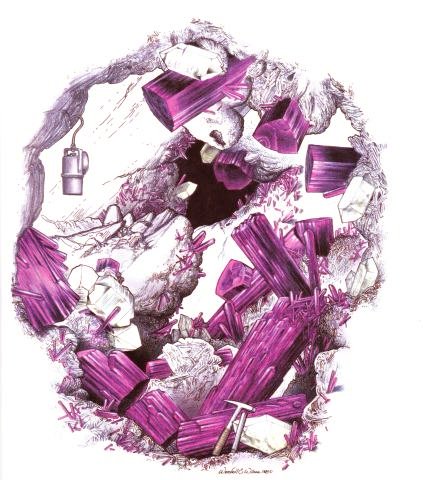 |
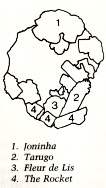 |
 | |
| 1 ジョニーナ(Small
Jonas) ジョナスの息子 352kg 50x25/30x25cm 2 太っちょ (Fat) 85x30cm 82kg 3 ゆりの花 30cm (Lily Flower) 4 ロケット (Rocket) |
|||
| 発見された晶洞内部の復元図 晶洞(Pocket) : 2.5x3.3m How the Jonas pocket may have looked when first discovered, Drawings on he right shows the major pieces Painting : Wendell Willson |
JIFLM(Jonas-João Pinto-Itatiaia-Farra-Lajão-Matias)
鉱山群 ゴヴェルナドール ヴァラダレスの東南凡そ50km JIFLM mines are located 50km south-east from Governador Valadares | ||
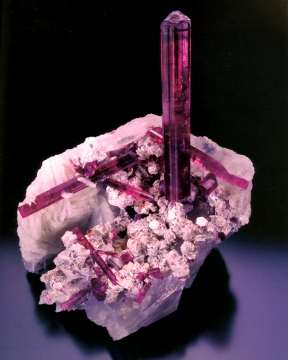 |
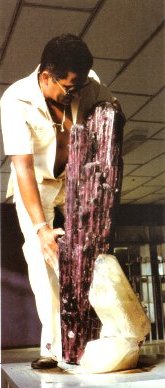 |
 | ||||
| 1978年の晶洞の発見時に採集された結晶 上の図の”ロケット”結晶の先端に描かれている 16.1cm Huston Museum of Natural science |
修復された”ロケット” 107cm 135kg Reconstructed "The Rocket" with discoverer, Ailton Balbosa |
バルボーサの父親が発見したイタチアイア鉱区の 多色の”オウム” トルマリン ”Parrot multi color tourmaline ” collected by Balbosa's father |
ジョナス・ポケット発見の物語 (History)
1930年代以来、イタチアイア丘陵一帯はミナス・ジェライスで最も重要なペグマタイト地帯として知られていました。
イタチアイアの初生鉱床では何百kgもの”オーム”と呼ばれる多色のトルマリンが、その付近の漂砂鉱床からは長年にわたり何トンもの宝石質の緑のトルマリンが採掘されて来ました。
しかしジョナス鉱山が世界的に知られるようになったのは1978年のブラジルの宝石採掘史上最大といわれる空前のルベライト晶洞の発見でした。
以下はアイルトン・バルボーサが晶洞を発見するまでの物語です ;
宝石仲買人のバルボーサがゴヴェルナドール・ヴァラダレスの同業者、ジョナス・リマに以前はジョアン・ピント鉱山と呼ばれていた鉱区をリースで採掘しないかと持ちかけ、話がまとまったのは1977年のことでした。
金持ちのジョナスがたったの1000クルゼイロ(70ドル程)の格安のリース料と全ての採掘の経費を負担し、バルボーサが実際の採掘を取り仕切るという段取りでした。
実は1930年代に”オウム”と呼ばれる多色のトルマリンを発見したのは鉱夫だったバルボーサの父親でした。
バルボーサ自身も何時の日か大鉱脈を掘り当てて、しがない宝石仲買人生活から抜け出すことを夢見ていたのでした。
金持ちのジョナスと組むことで、ようやくその夢の実現への一歩を踏み出すことが出来たというわけです。
1977年10月にバルボーサは4人の鉱夫と共に小さなトンネルをさらに水平に掘り進み始めました。
4ヶ月間の採掘の成果は5cmほどの曹長石に貫入している何本かのマッチ棒ほどの緑色のトルマリンだけでした。
が、1978年2月始めにいくつかの大きな晶洞を掘り当てることが出来ました。
しかし採れたのは3トンもの曹長石と価値のない黒いショールだけでした。
ジョナスはバルボーサに一旦採掘を休止することを提案しましたが、しばらくしてもう一度試みることにしました。
4月のはじめ、6ヶ月間の高価な爆破作業と採掘が徒労に過ぎ去ったことに失望したジョナスはバルボーサにもう手を引くと、そしてこれ以上の資金提供も出来ないと告げました。
トンネルの壁に宝石質トルマリンを前兆であるレピドライト(リシア雲母)の斑点を見出していたバルボーサはしかし、必ず夢のようなポケットを発見できると確信していました。
そしてジョナスに腕くらいの太さのルベライト結晶がある巨大な晶洞が見つかるに違いないと何度も念を押したのでした。
後にバルボーサが語ったところでは、実のところかつてそんなルベライトを見たこともなかったが、しかし必ず見つかるに違いないと予感していたとのこと。
またジョナスもバルボーサの語ったルベライト結晶の叙述は信じられないほど正確だったことを認めています。
6ヶ月間の爆破と採掘で30mの片岩と2,3mのペグマタイトのトンネルを掘り進み、世紀の発見の寸前にバルボーサはついに二つ目の大きな晶洞に達しました。
しかしここでも発見されたのは泥と水と水晶と雲母と曹長石と共に不透明なピンクの帽子付の大きな、しかし価値のない黒いショールでした。
既に自らの資金も使い果たしていたバルボーサは、しかし25cmもの大きなピンクと黒のトルマリンの発見に最後の望みをつないで、あと1週間分の採掘の費用と食費を捻出するためにフォルクスワーゲンを抵当に入れていました。
そしてこの食料とダイナマイトが尽きたなら、それでおしまいにするとジョナスに告げました。
The Itatiaia Hillside encompasses one of the largest and most important pegmatite regions in Minas Gerais. For almost 50 years, the Itatiaia mine produced hundreds of kilos of multicolored "parrot" tourmalines ; nearby alluvial deposits have yielded literally tons of green gem tourmaline over the years. The Jonas mine is within 1 km of Itatiaia mine (now largely inactive), where garimpeiro Barbosa first found the famous "parrot" tourmalines in the early 1930s.
The hard rock pegmatite body now known as the Jonas mine was first tunneled by a local farmer João Pinto, in the early 1940s. For several years it produced superb four- and five-colored pristine crystals up to 12cm long.
The modern history of the Jonas mine began to unfold in 1977, which Ailton Balbosa told well-to-do gem dealer Jonas Lima of
Governador Valadares of his determination to one day mine Itatiaia as his father had done and find many fabulous gems. Ailton, also a gem dealer, invite Jonas along him to the rancher-owner of the Itatiaia hillside that Ailton had coveted for so many years.
The land owner knew Ailton and agreed to lease the mine to Jonas, who was to put up all the operating capital, on condition that Ailton would supervise the mining. The lease payment was only 1,000 cruzeiros(roughly US$70) per month.
With the crew of only four garimpeiros, Ailton started mining in October 1977 by extending short tunnel horizontally into the enclosing schist and pegmatite. They worked four months with little success, finding only some matchstick-sized green tourmalines attractively arranged on 5-cm white albite crystals. In early February 1978, they finally penetrated several large pockets, but all they removed were three tons of worthless black tourmaline crystals mixed with albite.
Ailton and Jonas stopped working together for a while after this disapointing start, but later Jonas went to Ailton to try again.
On the first of April, after six months of fruitless and expensive blasting and digging, and only a week bofore the big discovery, a discouraged Jonas told Ailton he wanted to call it quits ; he would not go on without some financial support.
Ailton, who has more faith than any other garimpeiros had found occasional patches of lepidolite - the best overall indicator of gem tourmalines - on the pegmatite wall. Ailton told Jonas three times that they must go on, and promise Jonas what appeared to be a wild fantasy: " a huge gem pocket and rubellite as thick as his forearm." Ailton later confided that he didn't know that much about rubellites at the time and had never seen one that big, but he had a very strong premonition that he would find such crystals. Jonas was to find Balbosa's descriptions of the crystals incredibly accurate.
After drilling and blasting through 30m of schist and only a few meters of pegmatite, Ailton, only a few days away from the big discovery, finally blasted into a second big pocket - again containing large, worthless crystals of opaque black tourmaline with opaques pink tops and albite mixed with water, mud, and much quartz and mica. Ailton was near financial exhaustion himself, but the 25cm black and pink crystals encouraged him to go on. Ailton even surrendered the title of his Volkswagen to raise the money for food and mining for just one more week, he promised Jonas that when the food and the dynamite ran out, he would finally abandon the mine.
価値のない晶洞を片付けながら、しかしバルボーサは上から漏れてくる水はひょっとしてもう一つの晶洞からではないかと思い当たり、ハンマーと小規模なダイナマイト爆破とで上方への採掘を慎重に進め、水が漏れてくる方向に腕を伸ばせるほどの穴を穿ちました。
奇しくも1978年の聖金曜日の日に(復活祭の直前の金曜日)暗闇に伸ばしたバルボーサの腕が手探りでつかんだものはバルボーサとジョナスとの人生をすっかり変えてしまうほどの代物でありました。
引き戻した手の中に握られていたのは透明なルベライトだったからです。
バルボーサの懐中電灯で照らし出された巨大な晶洞の壁に無数の宝石質のルベライト結晶が赤く煌めいていましたた。
一昼夜かけて掘り進み、人が通れるほどに開いた入り口の先には高さ3m、奥行き3m、幅2.5mものぽっかりと開いた晶洞があり、中には雪のように白い曹長石と透明な水晶、それにピンクのリチウム雲母に包まれたルベライトの結晶の連なりでした。
ルベライトの多くは両端が整っている結晶でした。
晶洞の中が殆どクリーンで、鉱物類の風化や化学変化がまるで起こっていなかったことも特筆すべきことでした。
汚れを落とす必要もないほど結晶がきれいな状態で産出したのも稀なる出来事でした。
まさにかつて発見された最上の、最も価値のある、驚くべきペグマタイト晶洞の発見でありました。
こうした光景を目の当たりにした男たちの畏怖と感慨とが如何ばかりのものであったか ? ただジョナス一人のみが何百万ドルもの富を手にしたことを確信していたのでしたが。
この晶洞はたちまちにしてバンブーリオ(大当たり)ポケットとして世界に響き渡り、宝石産地としてジョナスの名が記憶されることになったのでした。
この晶洞からは少なくとも200kgの最上のクランベリー(ツルコケモモ)色のファセット級の結晶が採れました。
一つの結晶だけからでも卸値で百万ドル相当のルースがカットされたほどです。
さらに3600kgの標本級のマトリクスと結晶とが採掘され、史上最大のトルマリン晶洞の発見でありました。
通常の柱状結晶のトルマリンとは異なり、太いジョナス産ルベライトの結晶からは大きなルースをc軸に直角にカットすることが出来るほどでした。
研磨されたルースはその輝きと色合いとファイアーによって最上のトルマリンの一つとされていますが、しかし世界的な宝石鉱物収集家で、同時に宝石業者でもあるキース・プロクター氏の意見では、最上のものはオウロ・フィーノ鉱山かクルゼイロ鉱山産のチェリーやルビー・レッド色のルベライトとのことです。
4つの大きな結晶のうちジョニーニャはアメリカの個人の収集家に130万ドルで買い取られ、後にロケットも同じコレクションに納まりました。
As Ailton laboriously cleaned out this worthless chamber, he felt certain that the water entering from above indicated the exsistense of another pocket. So Ailton directed the excavation upward and, using hand digging and only partial sticks of dynamite, he carefully engineered and opening big enough to thrust his arm through into the area from which the water was drainning. This was on Good Friday, 1978, and as he first reached his arm into the hole and gropped above in the darkness, his and Jonas's lives were forever changed. For when he brought his hand out it contained a large, almost flawless, gem rubellite crystal. He then flashed his brightest mining light into the walls sparkling with the red of gem rubellites.
They dug all night and most of the next day to find the pocket was so big that they could walk right into it - with rubellites and albites crunching underfoot. Imagine the gem pocket - an oval 3m high, 3m long, and 2.5m wide - uniformly lined with rubellite crystals interspersed with just three other minerals : snow white albite, transparent quartz, and pink lithium-bearing lepidolite mica.
These three finely crystalized minerals provided the matrix into which the gem rubellites were nestled on the walls. Some of the rubellites had fallen, but most were intact. Many were doubly terminated - another rarity. Among the multitude of great surprise was the fact that the pocket was almost totally clean, virtually no chmical alteration had occured. And specimens were so clean that they did not even need to be washed. The elation and awe these men felt is beyond description.
Lying before their eyes was the richest, most valuable, and certainly most stunning pegmatite gem pocket ever seen by men.
Only Jonas knows how many millions of dollars lay there within his grasp.
This pocket became known worldwide as the bamburrio(jackpocket), and quickly claimed its place in gemstone lore.
The original Jonas pocket yielded, at best estimates, at least 200kg of fine quality cuttable crystals of an exceptional "cranberry" or deep magenta-red color. One crystal alone cut a million dollars(retail) worth of gems. Additionally, approximately 3600kg of specimen(rubellite with matrix) were removed. Both local and foreign experts agreed that this was the single most important find of tourmaline in history.
Because so many were fat, even large gemstones could be cut perpendicular to the c-axis. The finished gems were dazzling in color, brightness, and fire, said, they were among the finest rubellites known. According to Keith Proctor, however, even the best Jonas rubellites are not as good as the finest "cherry" and "ruby - red " stones from the Ouro Fino or Cruzeiro mines.
The Joninha was eventually sold to a private party in the United States for US$1,300,000, the Rocket was subsequently aquired fro the same mineral collection.
第2の晶洞の発見 (Discovery of the Second Popcket)
最初の晶洞の発見の3ヶ月後にジョナスと鉱山所有者との契約延長交渉が決裂し、採掘は放棄され坑道は爆破されました。
ついで採掘権を得たジレルマンド・メロ(通称ジロ)が別に130mのトンネルを掘り進めました。
2,3の曹長石に伴う小さな暗い緑のトルマリン晶洞を掘り当てたり、標本級のルベライト結晶や、見事な青いトルマリンをいくつかを得たものの、最初の数ヶ月は目覚しい発見はありませんでした。
しかしながら最初の晶洞発見の1年後、大きな晶洞にたどり着きました。
はやる気持ちを抑え切れなかったジロはダイナマイト爆破の直後に晶洞の穴に顔を突っ込んだために大量の煙を吸って病院に担ぎ込まれる羽目に陥ったほどです。
ようやく退院が許された日は奇しくも1979年の同じ聖金曜日でしたが、7.5cmの薄い曹長石の内側の壁を突き破って見出したのは、後に”イタチアイアの薔薇”と名づけられたクリーブランダイトの結晶に包まれた巨大なルベライト結晶でした。
この晶洞は内部が2−2.5mの大きさの楕円形をしていて内部は湿った砂で埋まっていました。”薔薇”はジョニーニャのように上下逆さまに天井からぶら下がっていました。そしてこの晶洞にはたった一つ、この薔薇の結晶があるのみでした。しかしこの結晶は最初の晶洞のそれよりも幾分明るい色合いをしていて、周囲のクリーヴランダイトも宝石質のものでした。
この結晶は1980年にアメリカ・コロラド州、コロラド・スプリングスのキース・プロクター・コレクションに収まりました。
以上がジョナスの二つの晶洞の発見の経緯です。
この一帯には幅12m、水平に200mの長さでうねって伸びているペグマタイト脈が存在すると考えられています。
しかし初生鉱床の硬い岩脈の採掘は余りにも費用がかかるために30mのみの採掘が行われた後は中断したまま手がつけられずに大部分が未発掘のまま残されています。
Within three months of the first discovery, Jonas had a disagreement with the land owner over the lease of the mine, and by late
July 1979, he had abandoned the operation. He also dynamited the tunnel shut about 30m inside the entrance.
A new lessee, Dilermando de Melo("Dilo") bagan minning immediately . In the ensuing two years, he opened tunnel 130m long. A few insignificant pockets with small dark green tourmalines on white albite were opened, and occasional rubellite specimens were found., but nothing truly exceptional was recovered during the first several months.
Surprisingly, Dilo found quite a few excellent gem blue tourmalines in this region of the pegmatite. Then in early April, a year after the first pocket discovery, Dilo and his miners encountered all the signs of another great find.
Working down through the pegmatite, they struck the outer wall of what appeared to be a large pocket, right beneath their feet on the floor of the tunnel. Quickly they set off the dynamite charge to open the pocket, and Dilermando, in his excitement, neglected to allow the necessary time for the gases to disperse. He went directly to the blast site and, leaning over to look into what he hoped was another Jonas pocket, was immediately overcome with the fumes from the explosion. His foreman took him to the hospital. When Dilo was released from the hospital, he and his partner went immediately to the mine. Coincidentally, Good Friday, 1979, again brought a choice discovery. The pocket was not yet open completely. Still remaining to be penetrated was a thin, 7.5cm layer of albite from the inner pocket wall. With picks and crowbars, they pried and finally broke loose a 45cm almost -square piece of this inner wall. With one person on each side, they carefully removed the section, fortunately by lifting straight up. When they turned it over, there on the other side of the piece was the beatiful Rose of Itatiaia.
This gem pocket, completely filled with moist sand, was a 2 to 2.5m oval inside. like the Joninha, the Rose was hanging upside down. suspended from the ceiling of the geode-like pocket. Surprisingly, this was the only one rubellite specimen in this second huge gem pocket. This Rose of Itatiaia is somewhat brighter in color than those of the first pocket. This 35cm long by 12cm wide gem rubellite crystal is nestled in a bed of gemmy albite crystals, was aquired in the summer of 1980 by Keith Proctor Collection, Colorado springs, Colorado, U.S.A.
So ends the saga of the Jonas rubellite mine. To this day, no other major rubellites have been found. Although considerable pegmatite remains, there is little activity in the area because of the expensive cost for hard rock operation.
イタチアイアの薔薇 (The Rose of Itatiaia) 43x33cm 400kg
伝説のジョナス鉱山の第2の晶洞から発見された唯一の結晶
The only specimen taken from the second pocket of the legendary Jonas mine.
Keith Proctor Collection
ジョナス鉱脈の特徴 (Occurence)
ルベライトの他にジョナス鉱山ではシャープな錫石と同じく微小なモナズ石の結晶,ピンクのアパタイト結晶と、稀な鉱物ミクロライトのシャープな結晶が発見されます。
しかし、その反面、白雲母や微斜長石、アクアマリン、トパーズ、スポジューメンといったペグマタイト鉱床に普通に発見される鉱物が発見されないという特異な鉱床もジョナス鉱山の興味深い特徴です。
Apart from famous rubellite crystal, Jonas mine produced sharp crystals of cassiterite, pink apatite, and the rare mineral of microlite were found in the pegmatite. Unusually sharp microcrystals of monazite were also frequently found.
It is significant to note that in Jonas mine, no muscovite mica nor microcline was found in either of the two great pocket, nor aquamarine, topaz nor spodumen was found.